
Katinka Lennemann
Seeds to Solutions Curriculum Coordinator and CCL Alumn
With the new school year kicking off in September, I’m excited to celebrate the publishing of Seeds to Solutions, a set of free, solutions-oriented environmental education resources for K-12 California students!
Back in 2022, I started working on the 7th grade unit at Global Nomads, and ended up spending over two years on curriculum development. Our unit focused on the phenomenon of land subsidence, eventually spilling out to the broader story of water management in California. At the Content Creation Lab, we used a unique model of curriculum development: this was developed for youth, by youth. As a team lead for an international group of students, I guided discussion on what content we wanted for the curriculum, and how we wanted it to be delivered.
We could have structured the unit like a good story, with lectures and textbook readings to tell students what happened. Instead, we wanted it to be like detective work: where students read primary documents, datasets, and facts about the phenomenon, then make sense of it and draw their own conclusions. It’s about empowering students to be curious about the complex world around them. Field test teachers have said that the curriculum motivates even students who are typically less engaged in class to dig into the lessons, which speaks to its relevance and power.
Through my research process, I also talked to dozens of individuals: hydrologists, water management specialists, indigenous leaders and educators, farmers in the Central Valley and more. I learned about the history of colonization, the decimation of indigenous livelihoods, and the disappearance of the largest lake in the Western U.S. All of these different perspectives and lived experiences unexpectedly tie back into this phenomenon of land subsidence, so we included them in the curriculum.
Besides context and history, we also included what people are doing to combat this issue and how students themselves might take action. A focus on the solutions had never been emphasized in my middle school climate education, which consisted mostly of melting glaciers and emaciated polar bears. I hope this curriculum gives the students the tools and information, but moreover, the hope needed to face climate change.
A big thank you to all the youth in the design process, whose tenacity and creative design of these youth underlie the content of the unit. To my incredible co-team lead Sophia Bispo from Brazil, who taught me so much about how to connect education to emotion. And to Katie Cox and Sandra Stein from Global Nomads Group, whom I had the honor to collaborate with and who made this unit what it is: accessible, grounded, complex, and moreover, fun!
About the author
Katinka Lennemann is a senior at UCLA studying Applied Mathematics and Statistics. Besides writing for Seeds to Solutions, she likes working with youth on climate action and advocacy. Once graduating, she looks to continue working in climate action through public policy or implementation projects. She served as a youth Team Leader in Global Nomads’ Content Creation Lab in 2022-2023.
